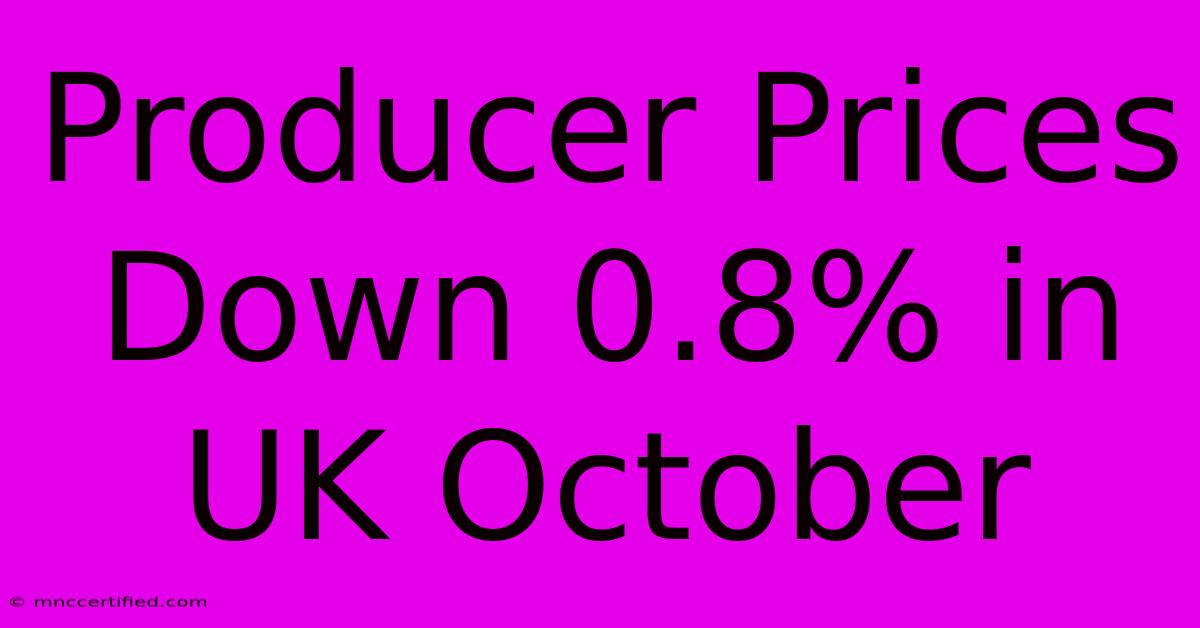Producer Prices Down 0.8% In UK October

Table of Contents
Producer Prices Down 0.8% in UK October: A Deeper Dive into Inflationary Pressures
The UK saw a significant drop in producer prices in October, falling by 0.8% according to the latest figures. This unexpected decrease offers a glimmer of hope amidst ongoing concerns about inflation, but a closer look reveals a more nuanced picture. This article delves into the details of this recent report, analyzing its implications for consumers, businesses, and the overall UK economy.
Understanding Producer Price Indices (PPIs)
Before analyzing the October data, it's crucial to understand what Producer Price Indices (PPIs) represent. PPIs track the average change in selling prices received by domestic producers for their output. Unlike Consumer Price Indices (CPIs), which measure the cost of goods and services for consumers, PPIs focus on the prices at the wholesale level. A decrease in PPI, as seen in October, suggests that producers are charging less for their goods. This can have a significant ripple effect throughout the economy.
Why the 0.8% Drop? Key Factors at Play
Several factors contributed to the 0.8% fall in UK producer prices in October. Experts point to:
- Easing energy prices: The ongoing decline in global energy prices, particularly natural gas, played a substantial role. Reduced energy costs translate directly into lower production costs for many businesses.
- Weakening demand: A slowdown in consumer spending and overall economic activity might have also pushed producers to lower prices to stimulate demand. This suggests a potential softening in the UK economy.
- Supply chain improvements: Although still facing challenges, supply chain disruptions are easing in certain sectors, leading to reduced production costs and subsequently, lower prices.
- Sterling's strength: The relative strength of the pound against other currencies can make imported goods cheaper, impacting producer prices.
Implications for the UK Economy
The 0.8% drop in producer prices is a double-edged sword. While it's positive news in terms of potentially easing inflationary pressures, it also reflects underlying economic vulnerabilities.
Potential Benefits:
- Lower inflation: The decrease in producer prices could eventually translate into lower consumer prices, offering relief to households struggling with the cost of living crisis. However, this is not a guaranteed outcome and depends on various other factors.
- Increased competitiveness: Lower production costs can boost the competitiveness of UK businesses in both domestic and international markets.
Potential Concerns:
- Weak demand: The decline could signal weaker-than-expected demand, indicating a potential economic slowdown or even recession. Businesses lowering prices to attract buyers suggests a struggle to maintain sales volumes.
- Delayed impact on CPI: It's important to note that the impact of lower producer prices on consumer prices may be delayed. The effects often filter through gradually.
Looking Ahead: What to Expect
The October PPI figures offer a snapshot of a complex economic situation. While the drop is encouraging, it's crucial to avoid premature optimism. Sustained decreases in producer prices are necessary to see a significant impact on inflation and the broader economy. Further analysis and monitoring of upcoming economic indicators, including CPI and GDP figures, are essential for a complete understanding of the UK's economic trajectory.
Further Research and Keywords:
For those seeking more in-depth information, researching keywords such as "UK inflation," "producer price index," "cost of living crisis," "economic slowdown UK," and "Bank of England interest rates" will yield relevant articles and reports. Staying informed on these topics is crucial for understanding the evolving economic landscape in the UK. Monitoring official government statistics and reports from organizations like the Office for National Statistics (ONS) provides reliable and up-to-date information.
Disclaimer: This article provides general information and analysis based on available data. It is not intended as financial or investment advice. Consult with qualified professionals for personalized advice.

Thank you for visiting our website wich cover about Producer Prices Down 0.8% In UK October. We hope the information provided has been useful to you. Feel free to contact us if you have any questions or need further assistance. See you next time and dont miss to bookmark.
Featured Posts
-
Investment Corporation Of America
Nov 20, 2024
-
Alabama Basketball Post Loss Analysis By Oats
Nov 20, 2024
-
Brazil Vs Uruguay Gerson Fede Draw
Nov 20, 2024
-
Bonded Wood Carpet Ada Compliant
Nov 20, 2024
-
Investment Property Interest Only
Nov 20, 2024